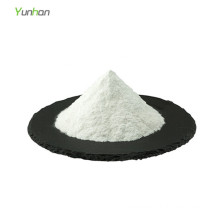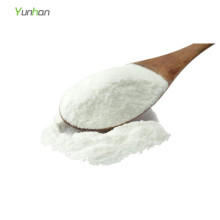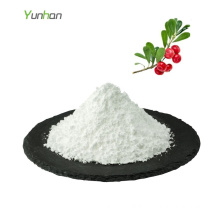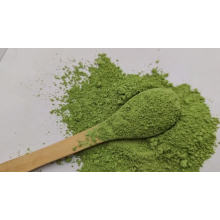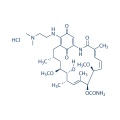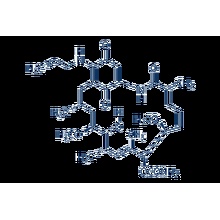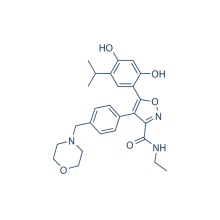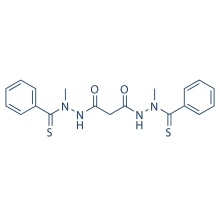17-DMAG (Alvespimycin) HCl 467214-21-7
Product Description
.cp_wz table {border-top: 1px solid #ccc;border-left:1px solid #ccc; } .cp_wz table td{border-right: 1px solid #ccc; border-bottom: 1px solid #ccc; padding: 5px 0px 0px 5px;} .cp_wz table th {border-right: 1px solid #ccc;border-bottom: 1px solid #ccc; padding: 5px 0px 0px 5px;}
Molecular Weight:
653.21 17-DMAG is a potent, water-soluble HSP90 inhibitor with IC50 of 62 nM. Phase 2.
Biological Activity
17-DMAG displays ~2 times potency against human Hsp90 than 17-AAG, with
IC50 of 62 nM versus 119 nM. In SKBR3 and SKOV3 cells which over-express
Hsp90 client protein Her2, 17-DMAG causes down-regulation of Her2 with
EC50 of 8 nM and 46 nM, respectively, as well as induction of Hsp70 with
EC50 of 4 nM and 14 nM, respectively, leading to significant
cytotoxicity with GI50 of 29 nM and 32 nM, respectively, consistent with
Hsp90 inhibition.
17-DMAG in combination with vorinostat
synergistically induces Apoptosis of the cultured MCL cells as well as
primary MCL cells, more potently than either agent alone, by markedly
attenuating the levels of cyclin D1 and CDK4, as well as of c-Myc, c-RAF
and Akt. In contrast to 17-AAG which is only active for IKKβ in
chronic lymphocytic leukemia (CLL) cells, 17-DMAG treatment effectively
leads to depletion of the Hsp90 client protein, resulting in diminished
NF-κB p50/p65 DNA binding, decreased NF-κB target gene transcription,
and caspase-dependent apoptosis. By targeting the NF-κB family, 17-DMAG
selectively mediates dose- and time-dependent cytotoxicity against CLL
cells, but not normal T cells or NK cells important for immune
surveillance.
17-DMAG treatment at 5 mg/kg or 25 mg/kg thrice per week significantly
reduces tumor growth of TMK-1 xenografts, by significantly reducing
vessel area and numbers of proliferating tumor cells in sections.
Consistent the inhibition of FAK signaling in vivo, 17-DMAG treatment at
25 mg/kg three times a week significantly suppresses tumor growth, and
metastasis of ME180 and SiHa xenografts in mice. Administration of
17-DMAG at 10 mg/kg for 16 days significantly decreases the white blood
cell count and prolongs the survival in a TCL1-SCID transplant mouse
model.
Protocol(Only for Reference)
Kinase Assay: [1]
Cell Assay: [5]
Animal Study: [5]
Conversion of different model animals based on BSA (Value based on data from FDA Draft Guidelines)
For example, to modify the dose of resveratrol used for a mouse (22.4 mg/kg) to a dose based on the BSA for a rat, multiply 22.4 mg/kg by the Km factor for a mouse and then divide by the Km factor for a rat. This calculation results in a rat equivalent dose for resveratrol of 11.2 mg/kg.
Chemical Information
Molarity Calculator
Dilution Calculator
Molecular Weight Calculator
Contact us if you need more details on 467214-21-7. We are ready to answer your questions on packaging, logistics, certification or any other aspects about Alvespimycin HCl 467214-21-7、17-DMAG HCl 467214-21-7. If these products fail to match your need, please contact us and we would like to provide relevant information.
Molecular Weight:
653.21 17-DMAG is a potent, water-soluble HSP90 inhibitor with IC50 of 62 nM. Phase 2.
Biological Activity
17-DMAG displays ~2 times potency against human Hsp90 than 17-AAG, with
IC50 of 62 nM versus 119 nM. In SKBR3 and SKOV3 cells which over-express
Hsp90 client protein Her2, 17-DMAG causes down-regulation of Her2 with
EC50 of 8 nM and 46 nM, respectively, as well as induction of Hsp70 with
EC50 of 4 nM and 14 nM, respectively, leading to significant
cytotoxicity with GI50 of 29 nM and 32 nM, respectively, consistent with
Hsp90 inhibition.
17-DMAG in combination with vorinostat
synergistically induces Apoptosis of the cultured MCL cells as well as
primary MCL cells, more potently than either agent alone, by markedly
attenuating the levels of cyclin D1 and CDK4, as well as of c-Myc, c-RAF
and Akt. In contrast to 17-AAG which is only active for IKKβ in
chronic lymphocytic leukemia (CLL) cells, 17-DMAG treatment effectively
leads to depletion of the Hsp90 client protein, resulting in diminished
NF-κB p50/p65 DNA binding, decreased NF-κB target gene transcription,
and caspase-dependent apoptosis. By targeting the NF-κB family, 17-DMAG
selectively mediates dose- and time-dependent cytotoxicity against CLL
cells, but not normal T cells or NK cells important for immune
surveillance.
17-DMAG treatment at 5 mg/kg or 25 mg/kg thrice per week significantly
reduces tumor growth of TMK-1 xenografts, by significantly reducing
vessel area and numbers of proliferating tumor cells in sections.
Consistent the inhibition of FAK signaling in vivo, 17-DMAG treatment at
25 mg/kg three times a week significantly suppresses tumor growth, and
metastasis of ME180 and SiHa xenografts in mice. Administration of
17-DMAG at 10 mg/kg for 16 days significantly decreases the white blood
cell count and prolongs the survival in a TCL1-SCID transplant mouse
model.
Protocol(Only for Reference)
Kinase Assay: [1]
| Fluorescence polarization (FP)-based competition binding assay | This assay utilizes a boron difluoride dipyrromethene (BODIPY) labeled geldanamycin analogue (BODIPY-AG) as a probe and measured fluorescence polarization upon binding of the probe to a protein. Native human Hsp90 protein (α + β isoforms) is isolated from HeLa cells. BODIPY-AG solution is freshly prepared in FP assay buffer (20 mM HEPES-KOH, pH 7.3, 1.0 mM EDTA, 100 mM KCl, 5.0 mM MgCl2, 0.01% NP-40, 0.1 mg/mL fresh bovine γ-globulin (BGG), 1.0 mM fresh DTT, and protease inhibitor from stock solution in DMSO. Competition curves are obtained by mixing 10 μL each of a solution containing BODIPY-AG and Hsp90, and a serial dilution of 17-DMAG freshly prepared in FP assay buffer from stock solution in DMSO. Final concentrations are 10 nM BODIPY-AG, 40 or 60 nM Hsp90, varying concentration of 17-DMAG (0.10 nM-10 μM), and ≤0.25% DMSO in a 384-well microplate. After 3 hours incubation at 30 °C, fluorescence anisotropy (γEx = 485 nm, γEm = 535 nm) is measured on an EnVision 2100 multilabel plate reader. IC50 value of 17-DMAG is obtained from the competition curves. |
|---|
Cell Assay: [5]
| Cell lines | Chronic lymphocytic leukemia (CLL) |
|---|---|
| Concentrations | Dissolved in DMSO, final concentrations ~1 μM |
| Incubation Time | 24, or 48 hours |
| Method | Cells are exposed to various concentrations of 17-DMAG for 24, or 48 hours. For the assessment of cytotoxicity, MTT reagent is then added, and plates are incubated for an additional 24 hours before spectrophotometric measurement. Apoptosis is determined by staining with annexin V-fluorescein isothiocyanate and propidium iodide (PI). |
Animal Study: [5]
| Animal Models | SCID mice engrafted with TCL1 leukemia cells | ||
|---|---|---|---|
| Formulation | Dissolved in DMSO | ||
| Dosages | 10 mg/kg | ||
| Administration | Intraperitoneal injection 5 times per week | ||
| Solubility | 1% DMSO/30% polyethylene glycol/1% Tween 80, 30 mg/mL | ||
| * Please note that Selleck tests the solubility of all compounds in-house, and the actual solubility may differ slightly from published values. This is normal and is due to slight batch-to-batch variations. | |||
Conversion of different model animals based on BSA (Value based on data from FDA Draft Guidelines)
| Species | Baboon | Dog | Monkey | Rabbit | Guinea pig | Rat | Hamster | Mouse |
| Weight (kg) | 12 | 10 | 3 | 1.8 | 0.4 | 0.15 | 0.08 | 0.02 |
| Body Surface Area (m2) | 0.6 | 0.5 | 0.24 | 0.15 | 0.05 | 0.025 | 0.02 | 0.007 |
| Km factor | 20 | 20 | 12 | 12 | 8 | 6 | 5 | 3 |
| Animal A (mg/kg) = Animal B (mg/kg) multiplied by | Animal B Km |
| Animal A Km |
For example, to modify the dose of resveratrol used for a mouse (22.4 mg/kg) to a dose based on the BSA for a rat, multiply 22.4 mg/kg by the Km factor for a mouse and then divide by the Km factor for a rat. This calculation results in a rat equivalent dose for resveratrol of 11.2 mg/kg.
| Rat dose (mg/kg) = mouse dose (22.4 mg/kg) × | mouse Km(3) | = 11.2 mg/kg |
| rat Km(6) |
Chemical Information
| Molecular Weight (MW) | 653.21 |
|---|---|
| Formula | C32H48N4O8•HCl |
| CAS No. | 467214-21-7 |
| Storage | 3 years -20℃Powder |
|---|---|
| 6 months-80℃in solvent (DMSO, water, etc.) | |
| Synonyms | NSC 707545,BMS 826476 HCl,KOS 1022 |
| Solubility (25°C) * | In vitro | DMSO | 131 mg/mL (200.54 mM) |
|---|---|---|---|
| Water | <1 mg/mL ( | ||
| Ethanol | <1 mg/mL ( | ||
| In vivo | 1% DMSO/30% polyethylene glycol/1% Tween 80 | 30 mg/mL | |
| * <1 mg/ml means slightly soluble or insoluble. * Please note that Selleck tests the solubility of all compounds in-house, and the actual solubility may differ slightly from published values. This is normal and is due to slight batch-to-batch variations. | |||
| Chemical Name | Geldanamycin, 17-demethoxy-17-[[2-(dimethylamino)ethyl]amino]-, monohydrochloride |
|---|
Molarity Calculator
Dilution Calculator
Molecular Weight Calculator
Contact us if you need more details on 467214-21-7. We are ready to answer your questions on packaging, logistics, certification or any other aspects about Alvespimycin HCl 467214-21-7、17-DMAG HCl 467214-21-7. If these products fail to match your need, please contact us and we would like to provide relevant information.
Product Categories : Cytoskeletal Signaling > HSP Inhibitor
Other Products
Hot Products
Astragaloside AChlortetracycline HCl 64-72-2Paclitaxel 33069-62-4Dexamethasone Acetate 1177-87-3Dinaciclib (SCH727965) 779353-01-4CHIR-124 405168-58-3Ro3280 1062243-51-9TAME 901-47-3CCG-1423 285986-88-110058-F4 403811-55-2Dabigatran (BIBR 953) 211914-51-1H 89 2HCl 130964-39-5T0901317 293754-55-9Aprepitant 170729-80-3Turofexorate Isopropyl (XL335) 629664-81-9BMS-378806 357263-13-9

